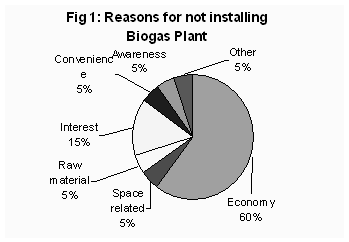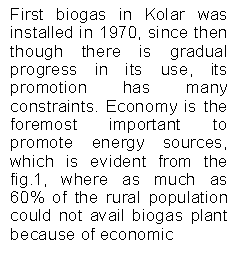Renewable Sources of Energy: Prospects and Issues
Biomass Energy
Biomass includes residues from forestry, purpose-grown agricultural crops, trees and plant types, organic waste, agricultural residue, agro-industrial and domestic origin waste [sewage and municipal solid waste]. On a worldwide scale Biomass contributes about 12% to today’s primary energy supply, rising between 40% and 50% in most developing countries. Biomass fuel obtained from purpose-grown energy crops as well as forests and agricultural waste are being used in power plants and it is very competitive in price and quality with fossil fuels. Applying biomass technology is both an environmental and human necessity, whether on a local scale to get rid of slurries, waste and refuses, or on a global scale to reduce carbon dioxide content in the atmosphere and hence reduce global warming.
Table: 4 - World potential for biomass energy supplies in the year 2050.
| Bioamss resource |
Potential annual supply in EJ |
| Energy crop |
128 |
| Dung |
25 |
| Forestry residue |
14 |
| Cereal residues |
13 |
| Sugar cane residues |
12 |
| Existing forest |
10 |
| Urban refuses |
3 |
| Total |
205 |
Source: Johnsson et al., 1992.
There are five routes to obtain energy from biomass
1. Production of crops which yield starch, such as sorghum, sugar such as sugar cane; cellulose such as Polar, Eucalyptus trees or other wood-forming trees; and oil such as Sunflower, Euphorbia etc.
2. Solid waste, which can be burnt.
3. Manure which produces biogas in digesters. The two common ones are the Indian floating top and Chinese covered top.
4. Landfill: This is a very ancient technique whereby all the municipal waste and refuse is accumulated in large ditches, valleys or specifically excavated holes in the land and the bacteria, decomposing waste, produces methane.
In 1990, there were over 240 landfill gas projects in operation worldwide, 90% of them in developed countries, about one third of them in USA. The largest one is in New York and produces 150,000/day. Germany has more than 70 projects, while UK has 35 projects. The UK projects are saving more than 400,000 tones of coal per year by using landfill energy and an electrical power generation of 22MW is achieved from a few of them.
5. Alcohol production: Many countries now-a-days have alcohol production plants, which utilise the alcohol directly in cars of partially mixed with petrol to upgrade the octane level, or it may be used by power station to generate electricity. Brazil is one of the leading countries in this technology where 13 x 106 tons of alcohol per year is produce which is sufficient to run 3 million cars per year.
Energy crops are being used globally. One of the most successful projects is that of Ashdown Environmental Company to grow trees which take 8 years to reach harvesting and use the solid arable coppice to generate 2.5 MW in Cornwall, UK.
The cost of electricity is about double the conventional one, but it is clean and does not contribute to the CO2 emission.
Box 5: Energy from waste in Kolar
Sericulture is a booming business all over Kolar. Mulberry ( Morus alba) is the plant species which serve as food for silk warms, therefore much of the agricultural land in the area is under Mulberry plantation. During different activities of silk production different kind of waste is generated which is effectively used as a source of energy in the area. During silk rearing huge amount of waste in the form of small twig and branches is produced, which is effectively used for cooking and water heating needs in the area. Andarhalli (a village) has undergone drastic shift from firewood to agriculture waste, where wastes cater 20% of the domestic energy need. Even the waste cocoons are dumped into the biogas pit along with cattle dung. Interestingly, it is seen that the biogas production is better with waste cocoon in it.
The extremely varied nature of the biofuels is a matter of controversy because of their present use and future potential. The tremendous potential of biomass has not been tapped properly, leading to their degradation which of foremost concern. Lack of adequate relevant information on different bioenergy resources in regional planning framework hamper efforts to develop alternatives to achieve multiple goals set by environmental objectives and the energy demand on the resource. Bioenergy continue to contribute significantly to the total energy consumption in most of the developing world. In domestic and rural industrial sector, they play a critical role. In this context it is necessary that the regional planning exercises formulate policies to develop sustainable bioenergy systems consistent with the objectives of ecodevelopment and environmental conservation.
Domestic activities such as cooking and water heating are the major thrust areas, where energy consumption in the form of bioresource is more in rural areas. Technological advancement, fortunately made way for cleaner energies such as biogas, electricity from biomass even in remote rural region. Of all renewable, non-conventional energy programs, biogas program in India is considered as a successful one, but only 10% of the available potential is harnessed so far.
Box 6: Biogas status in Kolar
Kolar District has a biogas potential, which can satisfy as much as 30- 40 % of domestic energy need in rural areas and at least 20% energy need of the total District. But unfortunately only about 5% of the potential is been tapped so far. If the untapped potential is tapped properly then energy crisis in rural Kolar can be minimised to large extent and tree felling can be stopped to a significant extent. Various reasons for not installing biogas plants are listed in Fig.1.
 

Biogas Usage: Biogas can be used for many purposes, mainly for cooking and lighting in rural area. Biogas can be burned with a gas mantle or can be converted to electricity, using a dual mode engine. The per capita requirement of gas for cooking is in the range 0.34-0.43 m3/day (efficiency of a standard burner is about 60%). The gas requirement to generate one unit of electricity (kWh) is about 0.54 m3. The calorific value of m3 of gas is about 4713 kcals.
Biogas Potential in Kolar:
- Taking dung yield for cattle as 3 kg/animal/day, for buffaloe 12 kg/animal/day. Per capita requirement of biogas as 0.34 m3/day. Kolar taluk data shows that in 132 villages biogas can meet energy demand of 15% of population. In 130 villages biogas potential is sufficient to meet 15-30% of population's energy requirements. In 30 villages Biogas can meet energy demand of more than 45% of village population.
- Taking dung yield for cattle as 7.5 kg/animal/day, for buffaloe 15 kg/animal/day. Per capita requirement of biogas as 0.34 m3/day. This shows that in Kolar 116 villages can meet domestic energy requirement of more than 45% of population, In 84 villages potential can meet 30 - 45% of population.
Firewood is a primary energy source and much of the world still relies on firewood for domestic and industrial energy need.
|